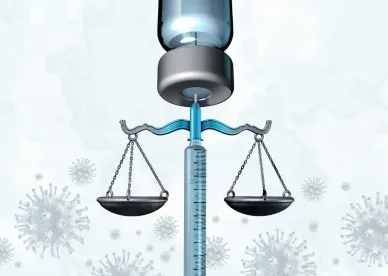On January 7, 2022, the Supreme Court of the United States heard oral argument on the cases challenging both the secretary of Health and Human Services’ interim final rule and the secretary of Labor’s emergency temporary standard (ETS). At the time of the argument, the CMS vaccine rule was temporarily enjoined in 25 states and enforceable in 25 states, and the OSHA ETS was alive and enforceable in all 50 states.
On January 13, 2022, in a 5-4 split decision, the Court issued an opinion staying the injunctions against the healthcare interim final rule, which allows the Centers for Medicare & Medicaid Services (CMS) to now enforce its vaccine mandate nationwide (with the key compliance dates now being January 27, 2022, and February 28, 2022).
First, the Supreme Court “agree[d] with the Government that the Secretary of Health and Human Services ’s rule falls within the authorities that Congress has conferred upon him.” The majority then reasoned that “Congress has authorized the Secretary to impose conditions on the receipt of Medicaid and Medicare funds” and that “COVID–19 is a highly contagious, dangerous, and—especially for Medicare and Medicaid patients—deadly disease.”
The Supreme Court held that, because “[t]he Secretary determined that a COVID–19 vaccine mandate will substantially reduce the likelihood that healthcare workers will contract the virus and transmit it to their patients, [h]e accordingly concluded that a vaccine mandate is ‘necessary to promote and protect patient health and safety’ in the face of the ongoing pandemic.”
The majority opinion also noted that the CMS’s “interim rule is not arbitrary and capricious” nor did the secretary (contrary to the states’ arguments against the interim final rule) “‘entirely fail to consider’ that the rule might cause staffing shortages, including in rural areas.”
In the end, the majority stayed the earlier injunctions ordered against the CMS rule by the Western District of Louisiana and the Eastern District of Missouri. The Supreme Court’s stay will remain in place until after the respective circuit courts of appeal (for the Fifth Circuit and for the Eighth Circuit) and until the Supreme Court then rules with finality on the cases after the lower appellate court decisions.
While this litigation will continue in the Fifth and Eighth Circuit courts of appeal—and even though CMS can enforce its federal regulations, including a statement of clear preemption of any contrary state laws—healthcare organizations in many states will still need to deal with the potential inconsistencies between the federal mandate and the various state restrictions on employers’ ability to mandate vaccination. Furthermore, other states have threatened similar prohibitions if the federal mandate was allowed to stand like it has now been with the Supreme Court’s decision. We will continue to monitor those preemption issues and litigation.





 />i
/>i
